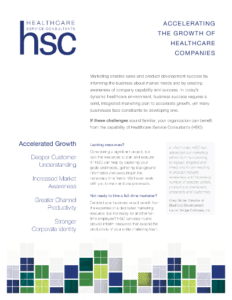Table of Contents
Yearly marketing planning should be a routine exercise, for any company. It’s essential to revisit and evolve your strategy, tactics, materials, and messaging in order to be successful year after year.
But, unlike other industries in the B2B and B2C spheres, healthcare possesses unique considerations.
Concept of Campaigns: Why Healthcare Is Unique
Consumers are often looking for the “next best thing.” B2C companies are consistently forced to come up with new campaigns. Customer retention and business growth often relies on adopting new trends in the market—and quickly. It’s common for B2C marketing planning to live on a quarterly cycle. Even some B2B companies outside of healthcare subscribe to a similar schedule.
Healthcare, with its long sales cycles, educated buyers, and multidisciplinary buying teams doesn’t work that way. Yes, the healthcare industry may be changing more rapidly now than a few decades ago. But in comparison to other industries, it’s a rather gradual progression. You can’t succeed by designing marketing for trend turnover. Instead, healthcare IT companies need to create marketing campaigns rooted in consistent communication of a company’s value proposition and conveyance of customer success.
However, that doesn’t mean healthcare IT companies shouldn’t investigate where change has occurred or should occur. Marketing needs to match those evolutions in customer thinking, shifts in priority, and emergence of new technologies to capture new proof points. As you look at the coming year, here are some areas you should consider.
The unique characteristics of B2B #HealthcareMarketing requires a delicate balance between evolution and revolution. When you understand those intricacies, you can design a marketing blueprint that remains customer-centric and solution-focused.
Marketing Channels
You may consider using new channels or expanding existing ones. Have you adopted video as a marketing strategy? How is your social media performing? Email marketing is another channel where you can look to expand your target audience. Is your content getting stale?
Trade Shows
New trade shows are always being developed, but these “shiny new objects” might not be the answer. Keeping the status quo with your trade show roster could also be detrimental. The start of the year is a good time to reassess which trade shows you attend. Which ones are frequented by your decision-makers or influencers? Avoid falling into the trap of trade shows that are geared towards investors or are simply developed to create hype. Trying to balance a mix of broader and focused niche shows can be a successful approach.
Messaging
While healthcare lives in the realm of consistency, the thinking of a healthcare buyer does evolve over time. They’re constantly striving to stay educated. What shifts have occurred in the market’s dynamics over the past 12 months that might be rendering your messaging less effective? Have you identified areas where stand-alone products are better served to be marketed as a suite of products?
Product Management & Development
Marketing doesn’t take place in a bubble. The new year is a great opportunity to visit with product development and product management teams to understand plans for the coming year. Even if a product won’t be ready for the market for many months, you can start to devise strategies and tactics in advance. This also helps you better integrate current marketing tactics into future product solutions.
Marketing Planning Now for Future Success
When it comes to yearly marketing planning, no one plan fits all. The unique characteristics of healthcare—and healthcare IT specifically—requires a delicate balance between evolution and revolution. When you understand those intricacies, you can design a marketing blueprint that remains customer-centric and solution-focused.
Photo by Alvaro Reyes on Unsplash




